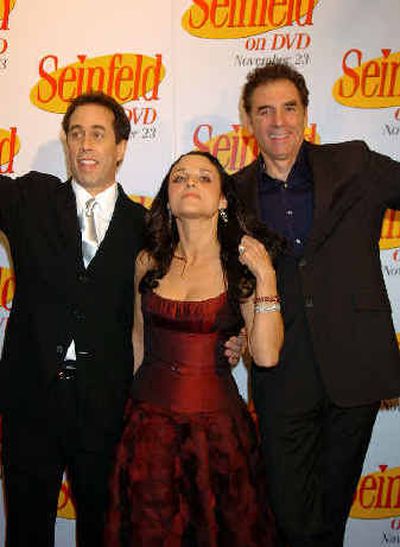DVDs about nothing

Yada yada yada. Millions of “Seinfeld” fans finally get what they’ve been waiting for so long: the first DVD of the hit show about nothing.
Two discs covering the first three seasons go on sale today, and the classic Jerry Seinfeld sitcom is expected to quickly become the master of its digital domain.
Huge advance orders from fans – eager to again see Jerry, Elaine, Kramer and George, the four wacky New Yorkers whom America came to love – have already pushed it up the top-seller lists.
Some experts predict “Seinfeld” will become the biggest-selling TV-show DVD of all time.
Not that there’s anything wrong with that.
For fans of the series – which drew some 76.3 million viewers to its farewell episode more than six years ago – it has been a long wait.
Internet fan sites have been inundated in recent days by hundreds of thousands of Seinfeld admirers talking about the DVDs’ finally being let out of “the vault.”
“People around the world started asking about four years ago if I knew when the shows would be released and how they can get hold of them,” said Steve Schlesinger, who set up one of the first Net-based “Seinfeld” fan clubs, Vandelay Industries (named after a fictional company from one of the episodes).
The two discs released today (each retailing for $49.95) truly are masterpieces of the DVD domain, packaging the thrill of rediscovery with a gold mine of brilliantly conceived bonus materials tied to “Seinfeld’s” early years.
The first four-disc collection, “Seinfeld – Seasons 1 & 2,” has the inaugural 17 episodes of the show, which began as “The Seinfeld Chronicles” on July 5, 1989. The next episode, downsized to “Seinfeld,” didn’t air on NBC until May 1990 as part of a four-show arc that ended the next month. This period now is known as “Seinfeld’s” first season.
Season 2, composed of just 12 episodes, began in January 1991 and ended that June. NBC still didn’t know what it had, and neither did most viewers.
NBC finally gave “Seinfeld” a traditional fall start in September 1991. A 23-episode run, comprising the four-disc “Seinfeld – Season 3,” ended in May 1992. The show remained ratings-impaired, and wouldn’t hit prime time’s top 25 until its fourth season.
Then came a five-season run in Nielsen’s top 5, capped by a May 14, 1998, finale that left the fab four of Jerry Seinfeld, George Costanza, Elaine Benes and Cosmo Kramer doing prison time for various crimes against common decency.
It all serves to make the first three seasons a far deeper archaeological dig than the high-profile years to come. All-time classics such as “The Contest,” “The Puffy Shirt,” “The Soup Nazi,” “The Pick,” “The Rye” and “The Sponge” were yet to be made and marveled upon. But Season 2’s “The Chinese Restaurant” and Season 3’s “The Parking Garage” had nothing to be ashamed of.
The pilot episode (two versions are on the DVD set) was without Julia Louis-Dreyfus’ indispensable Elaine Benes character. And to this day she’s never seen it, the “superstitious” Louis-Dreyfus says in one of the “Inside Look” extras that accompanies the great majority of episodes.
The first set also has full-length “Yada Yada Yada” commentaries on six episodes; deleted scenes; outtakes and bloopers; a one-hour documentary on the show’s origins; and nifty, printed “Notes About Nothing” that can be activated to run in tandem with each episode.
The “Inside Look” segment for the original “Seinfeld Chronicles” episode reveals that it was shot in the same studio as “The Dick Van Dyke Show.”
“It was a good luck charm, a very good luck charm,” says former “All in the Family” star Rob Reiner, who became an executive with Castle Rock, which made “Seinfeld” for NBC.
“Seinfeld Chronicles” now seems almost as primitive as those early snippets of “The Simpsons” within Fox’s “The Tracey Ullman Show.”
Jerry and George (Jason Alexander) first met at a small round table in Pete’s Luncheonette rather than in a booth at Monk’s. Kramer (Michael Richards) was first called “Kessler” and his hair hadn’t yet acquired its famed Harpo Marx pouf. His dog made its one and only appearance, jumping on George.
Seinfeld’s comedy club segments, dropped in later years, are very much a part of this first episode. He begins with a riff on going out and ends with the dynamics of male car-horn honking.
His labored acting is mostly an extension of the stand-up material; the banter and storytelling aren’t nearly as crisp as they’d become.
By Episode 40, the last one of Season 3, “Seinfeld” had both a history and a better sense of what it wanted to be. The episode ends with Kramer’s far-fetched trip to Hollywood, where he landed a guest appearance on “Murphy Brown” as the show’s latest office receptionist.
“I remember Larry (David) and I going onto the set of ‘Murphy Brown’ and being very impressed,” Seinfeld says.
“We thought we were doing an amateurish version of a real network sitcom. … ‘Murphy Brown’ was a real show, with big stars and a really organized crew, and everything seemed very professional. They had like good food at the craft services.”
At least no one told them, “No soup for you.” That would come later, in “Seinfeld’s” glory years.
They’ll be revisited in due time on future DVD sets. For now, though, it just doesn’t get any better than this.